Claire Law, Certified Educational Planner, CEP, is a nationally recognized college financial aid expert. She minimizes college costs and guides students to schools that are right for them. In today’s economy, students really need to assess themselves so they can plan for their personal and professional lives. Understanding their workplace preferences can help them search for suitable careers and college majors that prepare them for grad school or employment.
As the costs of four-year colleges continue to increase and the workplace demands change, it’s wise to evaluate the merits of a college and your family’s return on investment. Do this before your student falls in love with the wrong college!
Educational Avenues Financial Aid Advising:
- Assessment of parents expected contribution (EFC) under the Federal and Institutional Methodology (FAFSA, CSS Profile)
- Assessment of student’s academic performance
- Correction of college list
The above three variables make a huge difference in the amount of financial aid assistance or scholarships you will receive. Your financial aid award depends on
- which colleges your student applies to
- how he/she ranks within the applicant pool of the college
- how parents fit in within the aid policies of the college
How Family Income Affects Student Financial Aid
High-income Earners
High-income families often have high Expected Family Contributions that are as high or higher than the “COA” or Cost of Attendance. This doesn’t mean that these families can pay the full cost of an elite college, when the sticker price is $80,000 per year, or $320,000 over four years. I don’t shift financial assets, which in some cases could be illegal. Many tax breaks don’t lower your EFC and can turn into a pointless maneuver if your student is applying to a school that doesn’t meet need. But you too can find affordability by understanding how different colleges evaluate different families. Since 1998, I have visited hundreds and hundreds of colleges to assess their admission and financial aid policies. I know students. I know colleges. I know college financial aid. By working with me, your family and your student will grow to appreciate the cost-price relationship and choose the right college.
Middle-income Earners
Middle-income families need to shop for both merit and need-based aid. This can be a balancing act, not for the weak at heart! It’s difficult to tease out what amount of aid you receive that is based on merit or need. Colleges offer an amorphous mixture of the two, and there’s no transparency. Many families make too much to qualify for need-based aid and yet not enough to be able to pay for college. This is a donut hole, like there is in Medicare. My families gain more funding by asking the right questions and filing appeals when necessary.
Low-income Earners
Low income families need to knock on doors that fill a high percentage of demonstrated need. I’ve come across Pell-eligible students whose families had taken out huge Parent loans. These students need to cast a wider net and explore their options with a fine-toothed comb. Some didn’t realize that federal financial aid consists of loans. When you click on the FAFSA you are signing up for loans and any grants available. With the simple click of a button, students can sign for up to $27,000 over the four undergraduate years. The amount of debt here requires a careful consideration of the Return On Investment. Net price calculators aren’t always correct. These families need financial aid guidance the most. I am awed by their achievement despite the obstacles they often encounter. I do not charge Pell eligible students who have a zero EFC. Send them my way!

